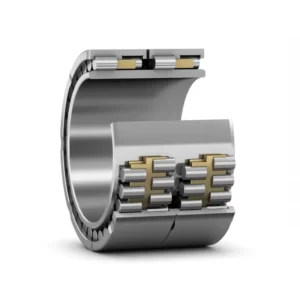1. What are Four row cylindrical roller bearings?
Four row cylindrical roller bearings are type of rolling-element bearing that is used in a variety of applications. These bearings have four rows of rollers, which are arranged in a staggered configuration.
This design provides for high load-carrying capacity and stiffness, while allowing for misalignment between the shaft and housing.
Four row cylindrical roller bearings are able to carry high radial loads and axial loads in both directions.
Four-row cylindrical roller bearings are typically made from high-quality materials, such as GCr15SiMn or Carburized steel.
These bearings are available in a variety of sizes and configurations to meet the specific needs of your application.

2. Where are cylindrical roller bearings used?
Cylindrical roller bearings are used in a variety of applications.
They are commonly used in automotive and industrial applications, including compressors, fans, pumps, rolling mills, roll neck, industry machine or equipment, and turbines.
They are also used in gearboxes and other power transmission systems. Cylindrical roller bearings are typically made from steel or other metals, and they can be either single- or double-row bearings.
3. Difference between taper roller bearing and cylindrical roller bearing?
There are several key differences between taper roller bearings and cylindrical roller bearings.
Taper roller bearings typically have a higher load capacity than cylindrical roller bearings, due to their design. Taper roller bearings also have a higher degree of misalignment tolerance than cylindrical roller bearings.
Additionally, taper roller bearings are typically used in applications where there is high axial and radial loads, while cylindrical roller bearings are more commonly used in lower load applications.
4. Four row cylindrical roller bearing specifications?
A four row cylindrical roller bearing is a type of rolling-element bearing that is used in a variety of applications.
The four-row cylindrical roller bearing has a higher load capacity than the two row and three row cylindrical roller bearings, and can accommodate radial loads, axial loads, or a combination of both.
The four row cylindrical roller bearing is also able to withstand high temperatures and vibration.
A four row cylindrical roller bearings are type of rolling-element bearing that is used in a variety of applications. The four row cylindrical roller bearings have a higher load capacity than the two row and three row cylindrical roller bearings, and can accommodate radial loads, axial loads, or a combination of both.
The four row cylindrical roller bearing is available in a variety of sizes and configurations to meet the needs of different applications.
5. Difference between spherical roller bearing and cylindrical roller bearing?
There are several key differences between spherical roller bearings and cylindrical roller bearings.
Spherical roller bearings have a barrel-shaped rollers that sit within a concave inner ring, while cylindrical roller bearings have flat-sided rollers held in place by flanges on an outer ring. This gives spherical roller bearings a greater ability to handle radial and axial loads in both directions, making them ideal for use in heavy-duty machinery.
Cylindrical roller bearings are better suited for high-speed applications where there is less need for load-bearing capacity.
6. How to install four row cylindrical roller bearing?
Cylindrical roller bearings are designed to handle radial and axial loads, and can accommodate misalignment between the shaft and housing. Installing a cylindrical roller bearing is a relatively simple process, but care must be taken to avoid damaging the bearing or the shaft.
To install a cylindrical roller bearing, first align the bearing with the shaft so that the rollers are perpendicular to the shaft. Next, insert the bearing into the housing, making sure that the rollers are properly seated in the races. Finally, secure the bearing in place with retaining rings or set screws.
7. Four row cylindrical roller bearings clearance
Four row cylindrical roller bearings are used in heavy duty applications where high radial and thrust loads are present. These bearings have a higher load carrying capacity than other types of roller bearings. The four rows of rollers provide increased stiffness and support for the heavy loads.
The clearance of these bearings is important to ensure proper operation. Too much clearance can cause the bearing to overheat and fail, while too little clearance can cause the bearing to seize and fail.
8. Features And Benefits Of Cylindrical Roller Bearings
Cylindrical roller bearings offer several advantages over other types of rolling-element bearings. they can handle both radial and thrust loads, as well as heavy loads. They can accommodate higher radial loads than ball bearings, and they can also accommodate some misalignment between the shaft and housing.
Cylindrical roller bearings are also relatively insensitive to shock loads, making them ideal for use in applications where impact loads are a concern. In addition, they are relatively low-maintenance and have a long service life.
9. More About EVERGLORY
EVERGLORY is one of China leading bearing manufacturers of 4 row cylindrical roller bearings.
EVERGLORY can make cylindrical bearings and taper bearings such as single row cylindrical roller bearing, double row cylindrical roller bearing, 4-row cylindrical roller bearing and single row taper roller bearing, double row taper roller bearing, four row taper roller bearing, and so on.
With 20 years of experience leading cylindrical roller bearing manufacturers, EVERGLORY is both manufacturer and exporter. If you have any inquiries about high-precision bearings, please contact us.


